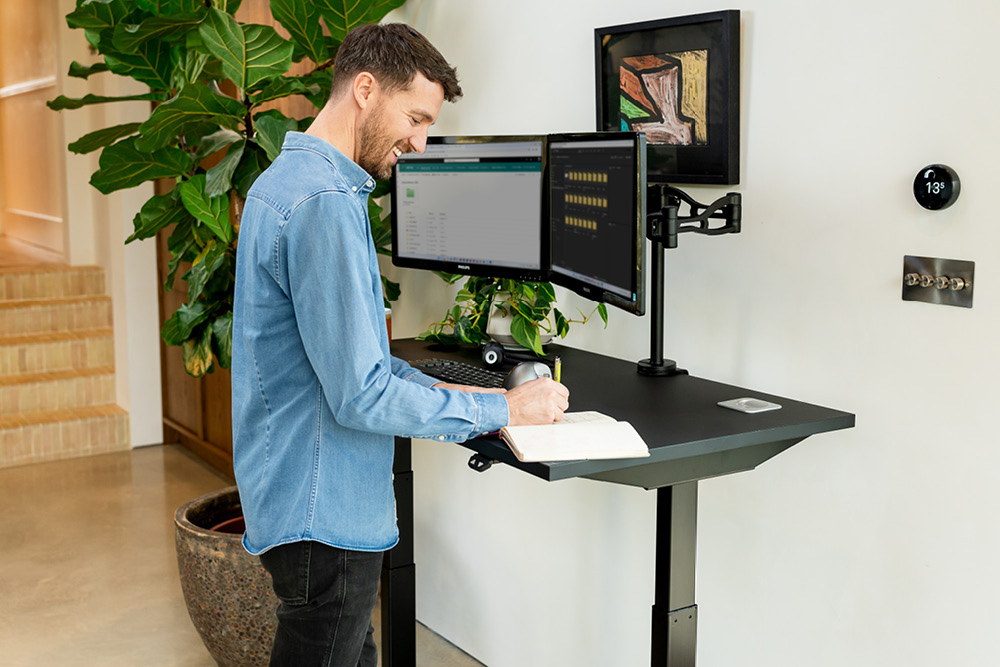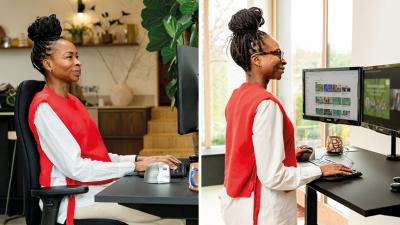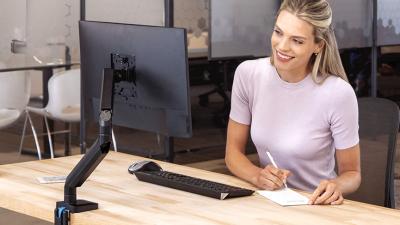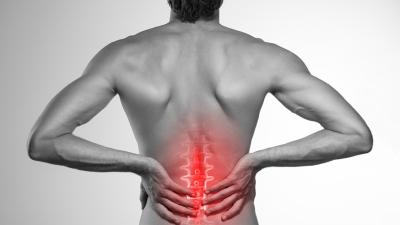
When I mention the term ‘active working’, does it make you think of a lithe 21-year-old in trainers bursting through the office doors? Fear not, because active working is generally a more gentle concept, which is great for everyone and involves desk setup improvements and small behaviour changes to introduce more movement into your working day.
Active working from home, at the office, or in any location is easy, accessible, and just feels good.
Simply remember to move and change position throughout your working day (use David Bowie’s track ‘Ch-Ch-Ch-Ch Changes’ to help you remember?). This is crucial for your long and short-term health and wellbeing: yet little is still being done by some employers to encourage active working.
In recent ergonomic research by Posturite’s partner Fellowes, only 17% of respondents said their line manager encouraged their staff to keep active and keep good posture when working at their desk.
In this blog, I’ll explain:
- How a correct ergonomic desk setup can help increase activity
- How employers can inspire active working
- The best desk setup for posture, and the efficacy of using sit-stand desks
- Sitting less as well as sitting better
- Office desk setup tips to help make active working a healthy habit

How does the concept of ‘static posture’ relate to ergonomic issues in an office desk setup?
The human body is built for movement. Our bones, muscles, cells, tissues, and organs all enjoy movement.
Static posture means maintaining the same position for extended periods. In the context of an office desk setup, this might be sitting, standing or kneeling at a desk. Static posture is the ‘enemy’ of ergonomic health because it can lead to muscle tension, discomfort and musculoskeletal disorders (MSDs).

Whereas in dynamic posture the body or parts of the body are moving. With active working, you’re aiming to:
- Reduce your time in static postures
- Increase your time using dynamic postures.

Risks of static posture
Back pain and spinal health
Back pain is one common risk of maintaining static posture and little movement. When maintaining static postures, the intervertebral discs in your back can experience prolonged pressure, causing them to retain less fluid. Over time, this can reduce the discs’ health and increase the risk of injury.

How movement and dynamic postures help
Regular movement at work and in leisure time helps your back maintain its natural range of motion and supports overall spinal health. When you reduce your sedentary time, you’ll help keep the muscles around the spine strong and coordinated, so they are able to provide more support to the joints and associated structures, so taking pressure off them.
Dynamic postures, including stretching and moving, can help to strengthen your core and consequently stabilise your spine and pelvis.

Long-term risks of chronic diseases
In the long term and looking specifically at sitting, research by the University of Leicester’s Sedentary Behaviour Research team found that people who spend a large proportion of their day sitting are at a greater risk of developing chronic diseases such as cardiovascular disease and type 2 diabetes and dying early compared to those who don’t.
Watch the webinar ‘Move more at work: treat your body and brain’ to see the small changes to working more actively that Dr Charlotte Edwardson saw succeed:
How can an ergonomic desk setup improve posture and movement?
When the key components of your ergonomic workstation setup are adjustable, you can make them fit your own body shape and size, and successfully support your posture. In addition to your all-important ergonomic chair, here are your top two pieces of ergonomic desk equipment to encourage movement while working:
1. An ergonomic office desk
Using a sit-stand desk, which allows you to adjust the desk height from sitting height to standing height, is a brilliant ergonomic solution. Often known as ‘standing desks’, ergonomic sit-stand desks give you the opportunity to vary your posture throughout the day by alternating between sitting and standing to work.
These height-adjustable desks are a great way to encourage movement and good posture because health and wellbeing experts recommend changing posture and reducing time spent in static postures. Your next posture really is your best posture!
When standing, it will feel natural to move around a little in your space and this movement will do you the world of good.
Best sit-stand desk solutions
- The JOSHO Electric Sit-Stand Desk is one good option for your active working setup. It’s no hassle to use; at the touch of a button, your desk surface and everything you need on it, your computer, monitors, files, keyboard and mouse – will rise up to your standing working position when you want to stand, and down again when you want to sit.
- A smaller and cheaper sit-stand desk is also available, called the KOJI Electric Sit-Stand Desk.
- Want a clever way to keep using your existing desk, but upgrade it to standing desk capability? Right, your solution is a sit-stand platform such as the top-rated Opløft. Pop it onto your desk and your ordinary desk will become a sit-stand desk; just squeeze the platform’s side handles to allow the surface to move up with all your desk equipment.
A desk setup featuring a sit-stand platform or desk can also boost your productivity. A Professor of Human Brain Research at UCL demonstrated distinct improvements in decision-making skills, language-based skills, concentration, vigilance and creativity in his trial of people using the Opløft for sit-stand working.
So, how long should you stand to work for? Try working up to standing at your standing desk for twenty minutes of every hour, preferably in a few bursts. It’s not recommended to stand for long periods. In My day of sitting and standing to work at home, you’ll meet a range of people who like a sit-stand desk setup and find out their preferred ways of dividing up their working days between sitting, standing and moving for different tasks.
2. An ergonomic monitor arm
Let me explain how using a monitor arm helps to improve your posture at work. A single or dual monitor arm allows you to easily adjust the height, angle, and tilt of your computer monitors, as well as their distance away from you at your desk. In this way, you’ll reduce strain on your back and neck by avoiding the bad posture caused by a screen that's:
- Too low or too high
- Too far away or too close
- Set at the wrong angle
These three desk posture mistakes can create back, neck and shoulder issues as well as eye problems and fatigue.

The additional plus points of your monitor arm are:
- How it frees up space on your desk, helping your office setup to look smart, tidy and professional.
- Its cable management features. For example, on a Platinum Series™ Monitor Arm, your cables will be tidied away and hidden within the arm.

How do you choose the correct position for your screen?
How you position your screen depends on your height, environment and task.
Quick tips are to:
- Position your main screen in front of you at about an arm’s length away.
- Your eyes should be level with the top part of your screen (for most people).
Find out more in A step-by-step guide to an ergonomic monitor setup.
Can’t decide between a monitor stand and a monitor arm? Get advice in this infographic.
What is the optimal desk height for an ergonomic desk setup?
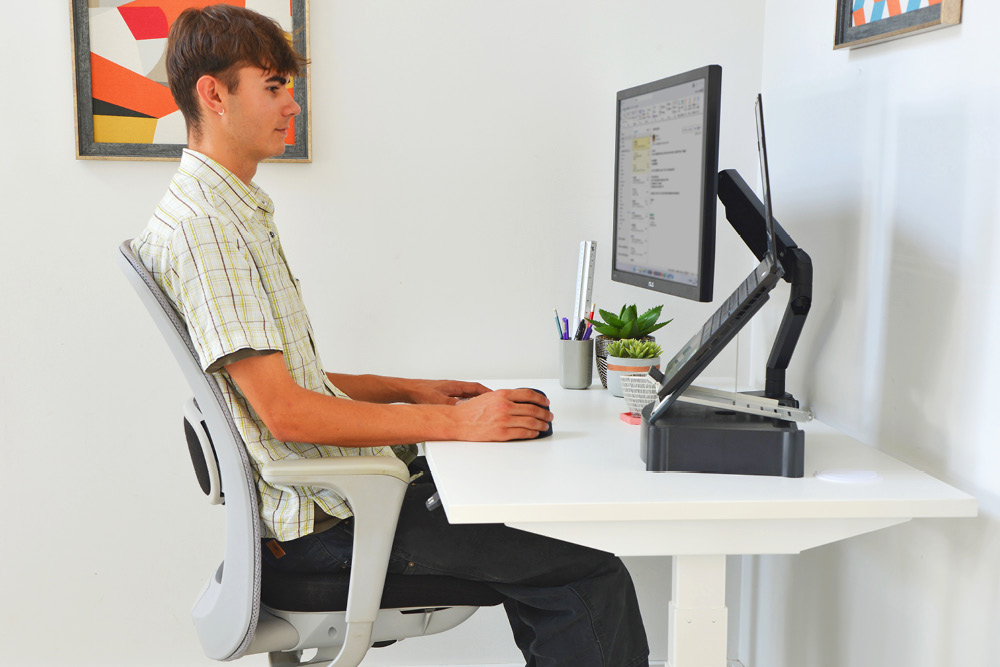
The correct height of your desk should allow you to work comfortably, and provide sufficient leg room. Follow the advice below to help prevent discomfort and pain from an incorrect desk setup and poor posture.
- Adjust your desk height so that your forearms are parallel to the desk surface with your wrist in a neutral position. Then you’ll be in an ergonomic position for comfortable typing. So the correct height of your desk will obviously be different for every person!
See this positioning on the Helpful hints for comfort at your desk advice sheet.

- Right desk height. Use the up/down switch on your desk to raise or lower your desk top, ensuring your forearms are parallel to the desk when you type.
- Ensure you sit comfortably. Sit back in your chair ensuring good back support leaving a small space behind your knees. Your feet should be supported on the floor or on a footrest.
- Relax. Keep your head upright and balanced, and your shoulders relaxed.
- To achieve an ergonomic desk setup, there should be enough room to find a comfortable position for all your limbs to move. A cramped workspace is uncomfortable and can create awkward movements.
On a height-adjustable desk such as the JOSHO, it’s very easy to just press the electric button up or down to get the desk height just right. And it’s a smooth transition with a good height-adjustable desk, there’s no juddering or instability.

What’s the optimal desk height when I’m using a standing desk?
The same ‘forearms parallel to the desk surface’ (usually about elbow height and parallel to the floor) advice applies to when you’re standing to work at a sit-stand desk too.
What shall I do if I can’t adjust the desk height at all?
If you don’t have a height-adjustable desk to help with your ergonomic positioning, the second-best option is to adjust your chair height to achieve this correct forearm alignment.
Use ergonomic office chair adjustments to get the right height for you at your desk so that:
- Your hips are slightly higher than your knees.
- Your feet are supported on the floor or on a footrest, not hanging unsupported.
- Your upper arms are relaxed by your body and, crucially, your shoulders are relaxed, not hunched up.
- Your forearms are parallel to the desk surface.

By the way, make these ergonomic chair adjustments to make yourself comfortable if you have a height-adjustable desk too. Just ensure the lumbar region in your lower back is well-supported by the seat cushion of your chair.
You’re all set!
Complete your ergonomic desk setup with an external ergonomic keyboard and mouse in addition to your desk, supportive and adjustable chair, and computer setup. Now you can take the business world by storm while you enjoy real comfort.
As we explored, movement is important to your working health, and the ergonomic desk setup tips here do encourage movement. Even when you’re busy, you’ll be more productive if you can avoid too much sedentary sitting, so a sit-stand desk is a perfect workmate.
Try active sitting too. By allowing you to move and fidget freely, active sitting chairs help you stay naturally alert without pulling your focus away from your tasks.
Further active working ideas include walking meetings, standing meetings, walking breaks, placing office kitchen equipment a small distance away, and strolling around to take phone calls.

If your posture at your desk is still causing you pain and discomfort, or if you have a health condition or injury to contend with at work, a DSE Assessment can be a great help.
A trained workstation assessor will guide you on your posture and positioning, assess how suitable your chair, desk and other equipment is, recommend how to prevent musculoskeletal disorders, and, if required, recommend the best ergonomic products for you personally.
As Dr Harrison Wein points out:
“Posture isn’t just about how you look. How you position yourself can help or hurt your health over your lifetime.”
Ergonomics is here to help us, and good posture (and plural good postures) plays a crucial role in our comfort and, therefore, our happiness and success at work.
Read next:






